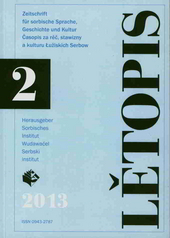Horst Schlossar. Dix-Meisterschüler, sorbischer Volksmaler, sozialistischer Realist und NVA-Künstler
Horst Schlossar. Pupil of Otto Dix, painter of Sorbian life, Socialist Realist und army artist
Author(s): Jonathan OsmondSubject(s): Fine Arts / Performing Arts
Published by: Domowina-Verlag GmbH / Ludowe nakładnistwo Domowina
Keywords: Socialist; Realist; Dix; Sorbian; Weimar Republic; painting; painter; Schlossar; Horst; Dix; Otto; Dresden; Maler; sozialistischer Realismus; neue Sachlichkeit; painter; socialist realism; new objectivity
Summary/Abstract: The career of the Dresden-born artist, Horst Schlossar/Šlosar (1903–1964), began in the Weimar Republic, continu-ed during the Third Reich and the Soviet occupation and concluded in the German Democratic Republic. These convulsions in Germany’s twentieth-century history are reflected in his work. This article sets out for the first time to integrate and evaluate the hitherto disparate facets of Schlossar’s life and work. Individual paintings and groups of works are analysed in respect of their connections to New Objectivity, Socialist Realism, reception of the German visual heritage, official commissioning of artworks, and the cultural life of the Sorbian population in the south-east of the GDR. A partial reconstitution has been achieved of Schlossar’s production before 1945, followed by: his depictions of Dresden after the bombing; the family portraits in the style of his professor, Otto Dix; the establish-ment of socialism; the political posters; the portrayals of Sorbian rural costume; the historical works; the agricultural and industrial development of Lusatia; and Schlossar’s collaboration with the National People’s Army. Particular attention is paid to significant pieces such as the large mural “Reconstruction” (1949) in Schloss Radibor and “Peasant Delegation to the 1st Socialist Artists’ Brigade” (1952/53), Schlossar’s most frequently exhibited and reproduced painting. On the basis of official documentation, press reports, personal correspondence, exhibition catalogues, and the artworks themselves, Schlossar’s political and cultural engagement in the life of the Sorbian population and the GDR is documented. It is contended that his works incorporate references to earlier German images and that the apparently naïve style of his figurative paintings and graphics was a deliberate attempt to connect art with the concerns of the working population.
- Issue Year: 2013
- Issue No: 2
- Page Range: 3-24
- Page Count: 22
- Language: German
- Content File-PDF

